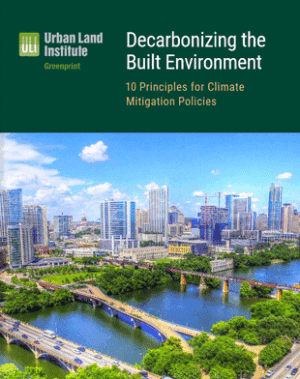In June, the Supreme Court restricted the Environmental Protection Agency’s ability to limit greenhouse gas emissions from power plants, striking a blow to federal efforts to combat global warming. This makes the path to building decarbonization more challenging, but not impossible, according to Breana Wheeler, U.S. director of operations for Building Research Establishment Environmental Assessment Methodology (BREEAM).
“A couple of key things aren’t changing,” Wheeler says. “One is investor concern about climate risk and their commitment to decarbonization. The second is that cities and states have already stepped up by, for example, bringing in building energy performance standards. And indeed, the Supreme Court’s decision might actually be a catalyst to encourage other jurisdictions to step in where they don’t see the federal government being able to go further.”
ULI Resources on Decarbonization:
- Electrify: The Movement to All-Electric Real Estate
- Ten Principles for Decarbonization: How Cities and the Real Estate Industry Can Partner to Fight Climate Change
- UL Basics: Decarbonization and Real Estate
- Net Zero Imperative
Even if utilities transition more slowly toward renewable energy sources as a result of the Supreme Court’s decision, the movement toward all-electric buildings is still as important as ever, Wheeler notes. “Electrification is the only way we can get to net-zero carbon,” she says. For the United States to transition toward a net-zero-carbon economy, those sectors of the economy that can more easily go to zero carbon should. “Effectively, the only fuel source that can be fully decarbonized is electricity,” she points out. “In the real estate sector and in buildings, it’s not easy, but we have the technology and the knowhow today to get to zero carbon.”
For investors and owners who have committed to reducing carbon emissions to net zero, “one of the biggest questions is, if you continue to have fossil fuels in your buildings and in your portfolio, how are you going to balance that?” Wheeler says. “Is it by generating more energy on your properties? Or where is that exactly going to come from? As a risk management strategy, electrification seems a better option in a lot of ways.”
Investors and developers can also speak up more about their commitments to decarbonization. “Everybody can look at the steps they’re taking to work with tenants,” Wheeler says. “And they can get involved in the communities in which they own assets to support the decarbonization effort, whether that’s through joining a committee where the municipality may be deciding on energy benchmarking, or simply talking about decarbonization as a resilience issue.” For example, energy-efficient housing lowers residents’ utility bills. “That addresses fuel poverty, it means they’re more productive, and they have better health and wellbeing,” she adds. “It has to be about people too.”



![Western Plaza Improvements [1].jpg](https://cdn-ul.uli.org/dims4/default/15205ec/2147483647/strip/true/crop/1919x1078+0+0/resize/500x281!/quality/90/?url=https%3A%2F%2Fk2-prod-uli.s3.us-east-1.amazonaws.com%2Fbrightspot%2Fb4%2Ffa%2F5da7da1e442091ea01b5d8724354%2Fwestern-plaza-improvements-1.jpg)


